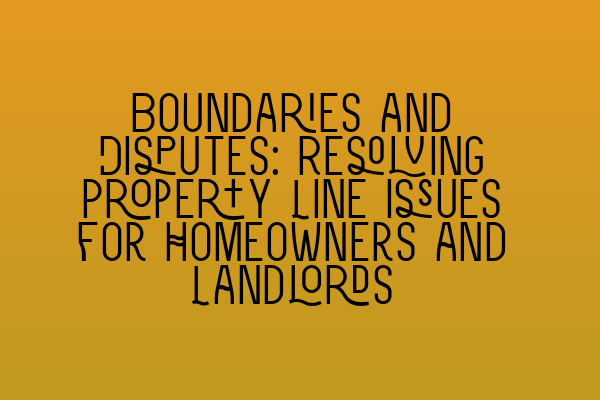Boundaries and Disputes: Resolving Property Line Issues for Homeowners and Landlords
Property ownership can be a source of pride and security for homeowners and landlords. However, a boundary dispute can quickly turn that sense of security into frustration and conflict. Whether you are a homeowner looking to expand your property or a landlord dealing with a dispute between tenants, understanding the intricacies of property lines and the legal remedies available is essential.
In this article, we will explore the common causes of boundary disputes, the legal principles governing property lines, and the methods to resolve such issues amicably. Let’s dive in!
What Causes Boundary Disputes?
Boundary disputes can arise from various factors, such as:
- Unclear or poorly defined boundaries
- Disagreements over fence placement
- Encroachment by one neighbor onto another’s property
- Disputes over right of way
These disputes can escalate quickly, leading to strained relationships between neighbors and even legal action. However, with proper understanding and proactive measures, many conflicts can be resolved without resorting to litigation.
Understanding Property Lines
Property lines are legal boundaries that define the extent of a property owner’s rights and responsibilities. These lines are typically recorded in property deeds and plans, but they can sometimes be open to interpretation or subject to changes over time.
When a dispute arises, it is crucial to review the relevant documents, including deeds, surveys, and official records. These documents often provide vital information about the exact location of property lines and any legal restrictions or easements that may affect them.
Resolving Boundary Disputes
Resolving a boundary dispute can be a complex process, but there are several methods to consider:
- Open Communication: In many cases, a dispute can be resolved amicably through open and respectful communication. Engaging in a constructive conversation with your neighbor or tenant can help identify the source of the disagreement and find a mutually beneficial solution.
- Mediation: If direct communication fails, engaging a neutral third party, such as a mediator, can be an effective option. A mediator can facilitate discussions between the parties involved and help find a compromise without the need for litigation.
- Professional Survey: A professional land survey can clarify property boundaries and provide an objective assessment of the situation. This can be particularly helpful when there are conflicting documents or differences in interpretation.
- Boundary Agreement: If both parties are willing, a boundary agreement can be reached, defining the boundaries and any shared responsibilities or easements. This agreement should be properly documented and legally binding to avoid future disputes.
- Legal Action: In some cases, despite all efforts to resolve the dispute amicably, legal action may be necessary. This typically involves filing a lawsuit to seek a court ruling on the matter. It is important to consult a qualified property law solicitor to guide you through the legal process and protect your interests.
Each situation is unique, and the appropriate resolution method will depend on the specific circumstances. However, it is always advisable to explore the less confrontational options before resorting to litigation.
Conclusion
Boundary disputes can be emotionally and financially draining for homeowners and landlords. However, with proper understanding and proactive measures, many conflicts can be resolved without the need for costly and time-consuming legal action.
If you find yourself in a boundary dispute, remember to approach the situation with open communication, seek professional advice, and consider alternative dispute resolution methods. This will not only help protect your rights as a property owner but also maintain neighborly relations.
For more information on related legal topics, check out these articles:
- Misrepresentation in Contracts: Unveiling Deceptive Practices
- A Closer Look at SQE Contract Law Syllabus
- SQE Contract Law: Analyzing Landmark Cases and Influential Judicial Decisions
- Contract Law for Services: Key Considerations and Best Practices
- Understanding Contractual Capacity: Rights and Limitations
